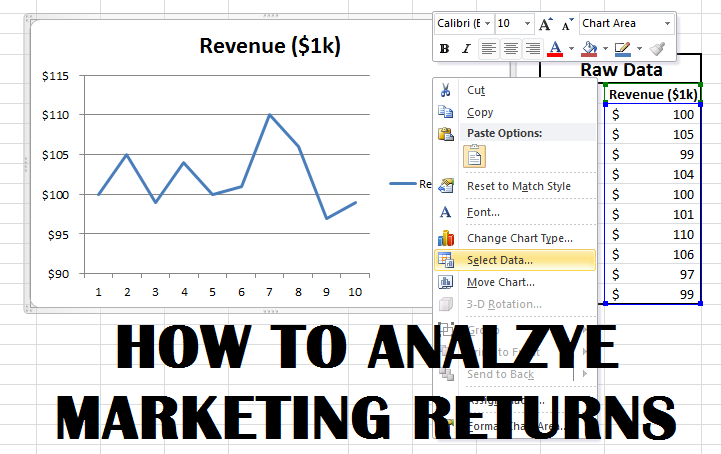
How To Analyze Marketing Returns
It is sometimes quite difficult to put a finger on direct and causative aspects of a marketing campaign. How much ROI did I really receive? How much would have been there any way? It’s hard to say. Even with A/B tools and other trendy ways of trying to pick the mind of the consumer, an accurate view on the financial return of marketing initiatives can be rather elusive. Fortunately, this is where cross functional teams shine best.
Enter the accountant.
One of my favorite ways of analyzing financial returns is through abnormal market models. Translated, comparing and contrasting your business’ finance before, during, and after marketing initiatives as compared to your historical finances as well as the current marketplace financial trends.
What this methodology essentially does is it gives a business perspective as to how they are doing compared to the economic health of their industry by comparing their current initiatives to their past successes. It also gives them a financial compass to where they should be if they were to keep status quo as compared to the marketing campaign they have chosen to carry out.
While this is a very numbers and data driven method of analysis. As such, it is severely accurate and has the added benefit of analyzing both short term and long term results as compared to the market norm. Moreover, it has the power to take into consideration numerous marketing initiatives as part of a marketing campaign in their combined contribution to a firm’s financial return of investment. For those of you who are really into research, this method of analysis is essentially a meta analysis on a company’s financial performance. Rather than comparing small bits of data to other small bits of data, this method compiles all of a firm’s data together to discern its financial significance.
To create a market model, you need to complete the following steps:
- First, gather your company’s historic financial data at least one time period out from your campaign. Meaning, if you wish to analyze a monthly marketing initiative which occurs the first week of every month, then you must at least make available the current month’s data as well as the past month’s data in order to make any meaningful analysis. Of course, the longer back the data goes, the better.
- Secondly, once you’ve gathered the data, input it into spreadsheet program such as Excel. Here’s an example for ten time periods (in this case months) along with the company’s associated revenue per month in hundred-thousand dollars.
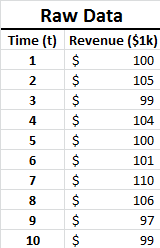
- Thirdly, plot your data so that you can get the equation that represents your financial trend. In Excel, you can do this by highlighting your financial data column and going to insert line graph as seen below:

- Then, you must correct your time component by right clicking on the graph that you’ve just created and selecting the option “Select Data.”
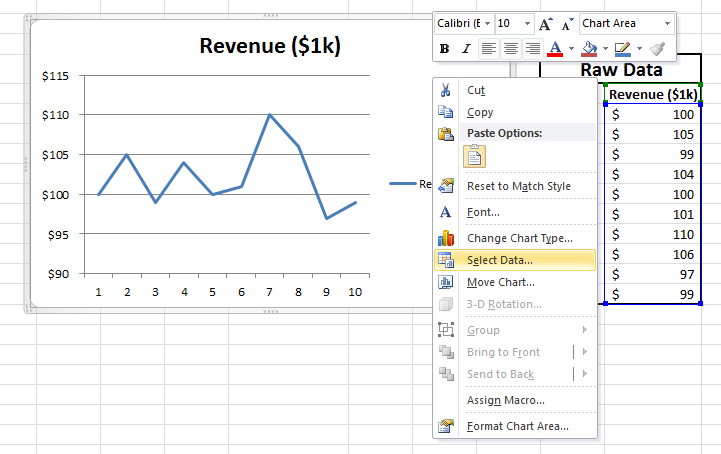
- Once you have clicked on “Select Data,” click on the “Edit” option under Horizontal (Category) Axis Labels to ensure that your graph adopts the right time horizon. Most of the time, Excel will correct for this if your time horizon is linear and distributed evenly. However, if your data comes in uneven chunks of time, you’ll definitely want to do this to make sure your data doesn’t become inaccurate due to faulty chronology.
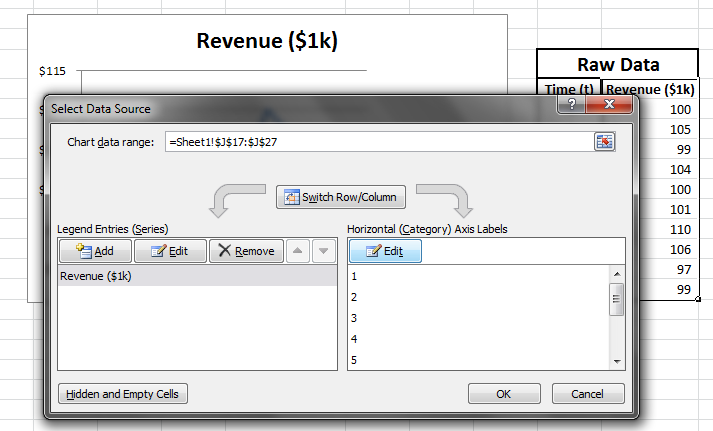
- To complete this step, highlight your time column as shown below:
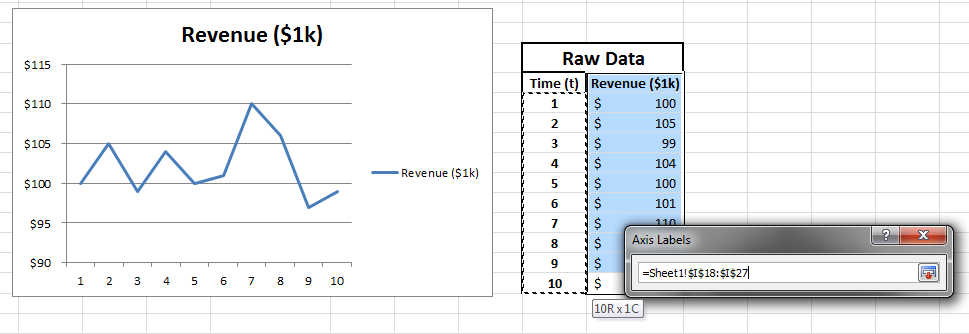
- Now that your graph is corrected, it is time to create the trendline which represents your finances as a mathematical model.
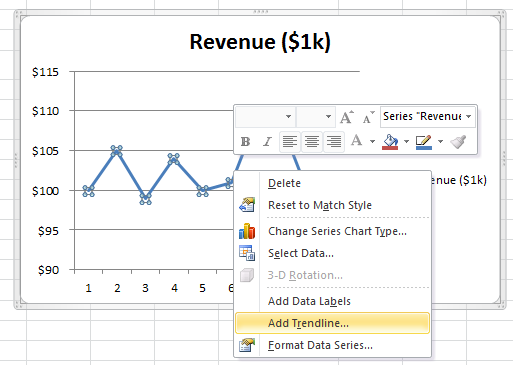
- For the sake of this example, just use a linear regression along with “Display Equation” and “R-squared on chart.”
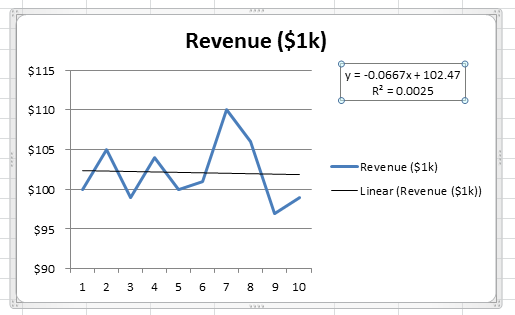
- Now for the interpretation. What your market model is telling you is that you started at time zero (the beginning of your time of survey) with a monthly revenue of $102k. However, you are losing roughly $70 per month with no explanation as of yet. You are confident that your model is greater than 99% (without getting into statistical terminology) accurate; this is because the R-squared value is 0.0025 which means it is likely to be 99.75% accurate. Still, just visually, there seems to be some widening of the confidence interval which can suggest some seasonal behaviors to your business.
Onward… To The Case!
At present, if this was our analysis of your business… it means you are losing money and we need to figure out why and fast. Not only is your current strategy costing you money, it is actually causing you to lose some type of market share and/or competitive advantage which is translating to your revenue stream. This was not unlike a case one of our team members was involved with regarding brand elevation.
A company was struggling with their brand positioning and had tried just about everything they could to get their brand out there. Unfortunately, there were some reputation issues based on old brand images which needed to be corrected. Additionally, the current marketing team felt that there was no need to change their strategy. It appeared that revenue from sales were steady and so why change? Things seemed good enough. Fortunately, the powers at be asked for a second opinion.
After analyzing their financials using the market model, it was apparent they were actually under performing compared to the rest of their industry. Not only that, they were losing money from their marketing strategy. A further look at their operations highlighted that they had mispositioned their brand. Customers saw them quite differently from how they saw themselves. By trying to sell their services at the highest end, they lost a lot of potential customers because the value and cost perceived were mismatched. By lowering their brand positioning, the benefit to the company immense, springing their business back into revenue growth and accelerating their success beyond the average performance of their industry at large. Such is the power of robust financial analysis when combined with solid choices in a renewed marketing strategy. Without the financial comparison to the market model, this company would have never known how poorly they were performing. As such, they had no idea what potential they left untapped! Imagine if they had just been happy that good was good enough; this business would have sacrificed an easy gain of a 20% increase in revenues.
If you think your company could benefit from such an analysis, please let us know! We are here to serve as accelerators of your success and our journey begins with a careful look at your situation, together. For more information and a FREE situation analysis, please visit Business Renovations.
Thank you for reading this post from October of 2015. UpDoc Media has since shifted from Business Renovations and now offers a Digital Media & Content Marketing service called POWERED By UpDoc Media. Woven into this service includes management consulting as well as business coaching.










